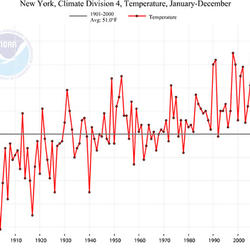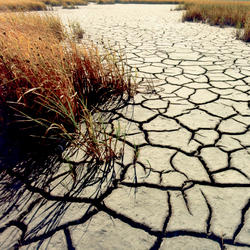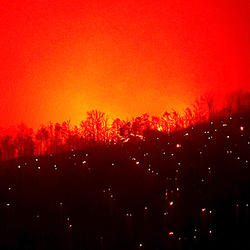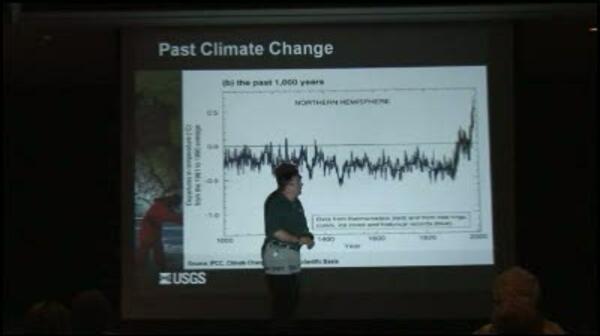Eroding permafrost on Alaska’s Arctic Coast. Inundation of permafrost like this produced subsea permafrost
What are the long-term effects of climate change?
Scientists have predicted that long-term effects of climate change will include a decrease in sea ice and an increase in permafrost thawing, an increase in heat waves and heavy precipitation, and decreased water resources in semi-arid regions.
Below are some of the regional impacts of global change forecast by the Intergovernmental Panel on Climate Change:
- North America: Decreasing snowpack in the western mountains; 5-20 percent increase in yields of rain-fed agriculture in some regions; increased frequency, intensity and duration of heat waves in cities that currently experience them.
- Latin America: Gradual replacement of tropical forest by savannah in eastern Amazonia; risk of significant biodiversity loss through species extinction in many tropical areas; significant changes in water availability for human consumption, agriculture and energy generation.
- Europe: Increased risk of inland flash floods; more frequent coastal flooding and increased erosion from storms and sea level rise; glacial retreat in mountainous areas; reduced snow cover and winter tourism; extensive species losses; reductions of crop productivity in southern Europe.
- Africa: Between 75 and 250 million people are projected to be exposed to increased water stress; yields from rain-fed agriculture could be reduced by up to 50 percent in some regions; agricultural production, including access to food, may be severely compromised.
- Asia: Freshwater availability projected to decrease in Central, South, East and Southeast Asia by the 2050s; coastal areas will be at risk due to increased flooding; death rate from disease associated with floods and droughts expected to rise in some regions.
Related
What is the difference between weather and climate change?
How do we know glaciers are shrinking?
How can climate change affect natural disasters?
How do changes in climate and land use relate to one another?
How do we know the climate is changing?
What are some of the signs of climate change?
What is the difference between global warming and climate change?
Why is climate change happening and what are the causes?
What causes drought?
What are the impacts of glacier loss, other than losing an aesthetic landscape feature?
Will global warming produce more frequent and more intense wildfires?
Does the USGS monitor global warming?
Eroding permafrost on Alaska’s Arctic Coast. Inundation of permafrost like this produced subsea permafrost
 A Record of Change: Science and Elder Observations on the Navajo N.
A Record of Change: Science and Elder Observations on the Navajo N.
A Record of Change—Science and Elder Observations on the Navajo Nation is a 25-minute documentary about collaborative studies using conventional physical sciences, combined with tribal elder observations to show that local knowledge and conventional science partnerships can effectively document ecosystem change and determine the resulting challenges to livelihoods.&
A Record of Change—Science and Elder Observations on the Navajo Nation is a 25-minute documentary about collaborative studies using conventional physical sciences, combined with tribal elder observations to show that local knowledge and conventional science partnerships can effectively document ecosystem change and determine the resulting challenges to livelihoods.&
 USGS Public Lecture: Warm Ice—Dynamics of Rapidly Changing Glaciers
USGS Public Lecture: Warm Ice—Dynamics of Rapidly Changing Glaciers
- Glacier Numerology – The how big, how long, how thick, how much, how often, of glacier science.
- Glacier Photography – While a picture may be worth a thousand words, a collection of images may tell a complete forensic story.
- Glacier Numerology – The how big, how long, how thick, how much, how often, of glacier science.
- Glacier Photography – While a picture may be worth a thousand words, a collection of images may tell a complete forensic story.
Eleven days after a wildfire first sparked south of Fort McMurray in northern Alberta, Landsat 8’s Operational Land Imager (OLI) captured imagery of one of the most destructive infernos in Canadian history. The fire has burned an area approaching 600,000 acres.
Eleven days after a wildfire first sparked south of Fort McMurray in northern Alberta, Landsat 8’s Operational Land Imager (OLI) captured imagery of one of the most destructive infernos in Canadian history. The fire has burned an area approaching 600,000 acres.
 PubTalk 10/2015 — Fire-climate Relationships in the Sierra Nevada
PubTalk 10/2015 — Fire-climate Relationships in the Sierra Nevada
Surprises relevant to future fire regime forecasts
by Jon E. Keeley, USGS Research Scientist
Surprises relevant to future fire regime forecasts
by Jon E. Keeley, USGS Research Scientist
 PubTalk 3/2014 — Preparing for California Climate Change
PubTalk 3/2014 — Preparing for California Climate Change
--Climatologists Look Back and Peer Forward
Dan Cayan, USGS Climate Change Researcher
--Climatologists Look Back and Peer Forward
Dan Cayan, USGS Climate Change Researcher
Spring 2014. USGS scientists conduct a health evaluation of a young male polar bear in the Arctic as part of the annual southern Beaufort Sea population survey. The bear is sedated for approximately an hour while the team records a variety of measurements and collects key biological samples.
Spring 2014. USGS scientists conduct a health evaluation of a young male polar bear in the Arctic as part of the annual southern Beaufort Sea population survey. The bear is sedated for approximately an hour while the team records a variety of measurements and collects key biological samples.
Walruses gathered by the tens of thousands in September 2013 to rest on the shores of the Chukchi Sea near the coastal village of Point Lay, Alaska.
Walruses gathered by the tens of thousands in September 2013 to rest on the shores of the Chukchi Sea near the coastal village of Point Lay, Alaska.

Neal Pastick – lead author of the study – investigating erosion along Alaska’s Arctic coastline near the village of Kaktovik. Permafrost-dominated coasts of Alaska have drastically changed as the result of coastal transgression and storm-surge flooding which can result in the loss of cultural sites and damage to infrastructure. Photo by M.
Neal Pastick – lead author of the study – investigating erosion along Alaska’s Arctic coastline near the village of Kaktovik. Permafrost-dominated coasts of Alaska have drastically changed as the result of coastal transgression and storm-surge flooding which can result in the loss of cultural sites and damage to infrastructure. Photo by M.
 PubTalk 11/2012 — Understanding Climate-Wildlife Relationships
PubTalk 11/2012 — Understanding Climate-Wildlife Relationships
-- are American pikas harbingers of changing conditions?
by USGS Research Ecologist Erik Beever
-- are American pikas harbingers of changing conditions?
by USGS Research Ecologist Erik Beever
Summer ice retreat in the Chukchi Sea between Alaska and Russia is a significant climate change impact affecting Pacific Walruses, which are being considered for listing as a threatened species. This twelve minute video follows walruses in their summer sea ice habitat and shows how USGS biologists use satellite radio tags to track their movements and behavior.
Summer ice retreat in the Chukchi Sea between Alaska and Russia is a significant climate change impact affecting Pacific Walruses, which are being considered for listing as a threatened species. This twelve minute video follows walruses in their summer sea ice habitat and shows how USGS biologists use satellite radio tags to track their movements and behavior.
 PubTalk 3/2010 — Changing Times-- A Changing Planet!
PubTalk 3/2010 — Changing Times-- A Changing Planet!
Using phenology to take the pulse of our planet
By Jake F. Weltzin, Executive Director, USA National Phenology Network
Using phenology to take the pulse of our planet
By Jake F. Weltzin, Executive Director, USA National Phenology Network
Climate change is an issue of increasing public concern because of its potential effects on land, water, and biological resources.
Climate change is an issue of increasing public concern because of its potential effects on land, water, and biological resources.
 USGS Public Lecture Series: Watching Nature's Clock: A Citizen-Scientist Effort to Track Seasonal Signs of Climate Change
USGS Public Lecture Series: Watching Nature's Clock: A Citizen-Scientist Effort to Track Seasonal Signs of Climate Change
USGS Public Lecture Series: Watching Nature's Clock: A Citizen-Scientist Effort to Track Seasonal Signs of Climate Change
linkA new USGS program, the USA National Phenology Network, is recruiting tens of thousands of volunteers to team up with scientists to help track the effects of climate on seasonal patterns of plant and animal behavior.
USGS Public Lecture Series: Watching Nature's Clock: A Citizen-Scientist Effort to Track Seasonal Signs of Climate Change
linkA new USGS program, the USA National Phenology Network, is recruiting tens of thousands of volunteers to team up with scientists to help track the effects of climate on seasonal patterns of plant and animal behavior.
These images show the nearly 11,000 acres affected by the Sierra fire in Orange County, California, in February 2006.
These images show the nearly 11,000 acres affected by the Sierra fire in Orange County, California, in February 2006.

Repeat oblique photographs of Gulkana glaciers in Alaska. 1967, Unknown USGS photographer. 2016, L. Sass, USGS.
Repeat oblique photographs of Gulkana glaciers in Alaska. 1967, Unknown USGS photographer. 2016, L. Sass, USGS.

Repeat oblique photographs of Wolverine glacier in Alaska. 1966 image by unknown USGS photographer; 2015 image by L. Sass, USGS.
Repeat oblique photographs of Wolverine glacier in Alaska. 1966 image by unknown USGS photographer; 2015 image by L. Sass, USGS.
Climate change and future water availability in the United States
U.S. Geological Survey climate science plan—Future research directions
Mechanisms by which marine heatwaves impact seabirds
Approaches for using CMIP projections in climate model ensembles to address the ‘hot model’ problem
Characterizing urban heat islands across 50 major cities in the United States
Monitoring and assessing urban heat island variations and effects in the United States
Using information from global climate models to inform policymaking—The role of the U.S. Geological Survey
Simulation of water availability in the Southeastern United States for historical and potential future climate and land-cover conditions
A record of change - Science and elder observations on the Navajo Nation
USGS Arctic Science Strategy
Remote sensing of land surface phenology
Delivering climate science about the Nation's fish, wildlife, and ecosystems: the U.S. Geological Survey National Climate Change and Wildlife Science Center
Related
What is the difference between weather and climate change?
How do we know glaciers are shrinking?
How can climate change affect natural disasters?
How do changes in climate and land use relate to one another?
How do we know the climate is changing?
What are some of the signs of climate change?
What is the difference between global warming and climate change?
Why is climate change happening and what are the causes?
What causes drought?
What are the impacts of glacier loss, other than losing an aesthetic landscape feature?
Will global warming produce more frequent and more intense wildfires?
Does the USGS monitor global warming?
Eroding permafrost on Alaska’s Arctic Coast. Inundation of permafrost like this produced subsea permafrost
Eroding permafrost on Alaska’s Arctic Coast. Inundation of permafrost like this produced subsea permafrost
 A Record of Change: Science and Elder Observations on the Navajo N.
A Record of Change: Science and Elder Observations on the Navajo N.
A Record of Change—Science and Elder Observations on the Navajo Nation is a 25-minute documentary about collaborative studies using conventional physical sciences, combined with tribal elder observations to show that local knowledge and conventional science partnerships can effectively document ecosystem change and determine the resulting challenges to livelihoods.&
A Record of Change—Science and Elder Observations on the Navajo Nation is a 25-minute documentary about collaborative studies using conventional physical sciences, combined with tribal elder observations to show that local knowledge and conventional science partnerships can effectively document ecosystem change and determine the resulting challenges to livelihoods.&
 USGS Public Lecture: Warm Ice—Dynamics of Rapidly Changing Glaciers
USGS Public Lecture: Warm Ice—Dynamics of Rapidly Changing Glaciers
- Glacier Numerology – The how big, how long, how thick, how much, how often, of glacier science.
- Glacier Photography – While a picture may be worth a thousand words, a collection of images may tell a complete forensic story.
- Glacier Numerology – The how big, how long, how thick, how much, how often, of glacier science.
- Glacier Photography – While a picture may be worth a thousand words, a collection of images may tell a complete forensic story.
Eleven days after a wildfire first sparked south of Fort McMurray in northern Alberta, Landsat 8’s Operational Land Imager (OLI) captured imagery of one of the most destructive infernos in Canadian history. The fire has burned an area approaching 600,000 acres.
Eleven days after a wildfire first sparked south of Fort McMurray in northern Alberta, Landsat 8’s Operational Land Imager (OLI) captured imagery of one of the most destructive infernos in Canadian history. The fire has burned an area approaching 600,000 acres.
 PubTalk 10/2015 — Fire-climate Relationships in the Sierra Nevada
PubTalk 10/2015 — Fire-climate Relationships in the Sierra Nevada
Surprises relevant to future fire regime forecasts
by Jon E. Keeley, USGS Research Scientist
Surprises relevant to future fire regime forecasts
by Jon E. Keeley, USGS Research Scientist
 PubTalk 3/2014 — Preparing for California Climate Change
PubTalk 3/2014 — Preparing for California Climate Change
--Climatologists Look Back and Peer Forward
Dan Cayan, USGS Climate Change Researcher
--Climatologists Look Back and Peer Forward
Dan Cayan, USGS Climate Change Researcher
Spring 2014. USGS scientists conduct a health evaluation of a young male polar bear in the Arctic as part of the annual southern Beaufort Sea population survey. The bear is sedated for approximately an hour while the team records a variety of measurements and collects key biological samples.
Spring 2014. USGS scientists conduct a health evaluation of a young male polar bear in the Arctic as part of the annual southern Beaufort Sea population survey. The bear is sedated for approximately an hour while the team records a variety of measurements and collects key biological samples.
Walruses gathered by the tens of thousands in September 2013 to rest on the shores of the Chukchi Sea near the coastal village of Point Lay, Alaska.
Walruses gathered by the tens of thousands in September 2013 to rest on the shores of the Chukchi Sea near the coastal village of Point Lay, Alaska.

Neal Pastick – lead author of the study – investigating erosion along Alaska’s Arctic coastline near the village of Kaktovik. Permafrost-dominated coasts of Alaska have drastically changed as the result of coastal transgression and storm-surge flooding which can result in the loss of cultural sites and damage to infrastructure. Photo by M.
Neal Pastick – lead author of the study – investigating erosion along Alaska’s Arctic coastline near the village of Kaktovik. Permafrost-dominated coasts of Alaska have drastically changed as the result of coastal transgression and storm-surge flooding which can result in the loss of cultural sites and damage to infrastructure. Photo by M.
 PubTalk 11/2012 — Understanding Climate-Wildlife Relationships
PubTalk 11/2012 — Understanding Climate-Wildlife Relationships
-- are American pikas harbingers of changing conditions?
by USGS Research Ecologist Erik Beever
-- are American pikas harbingers of changing conditions?
by USGS Research Ecologist Erik Beever
Summer ice retreat in the Chukchi Sea between Alaska and Russia is a significant climate change impact affecting Pacific Walruses, which are being considered for listing as a threatened species. This twelve minute video follows walruses in their summer sea ice habitat and shows how USGS biologists use satellite radio tags to track their movements and behavior.
Summer ice retreat in the Chukchi Sea between Alaska and Russia is a significant climate change impact affecting Pacific Walruses, which are being considered for listing as a threatened species. This twelve minute video follows walruses in their summer sea ice habitat and shows how USGS biologists use satellite radio tags to track their movements and behavior.
 PubTalk 3/2010 — Changing Times-- A Changing Planet!
PubTalk 3/2010 — Changing Times-- A Changing Planet!
Using phenology to take the pulse of our planet
By Jake F. Weltzin, Executive Director, USA National Phenology Network
Using phenology to take the pulse of our planet
By Jake F. Weltzin, Executive Director, USA National Phenology Network
Climate change is an issue of increasing public concern because of its potential effects on land, water, and biological resources.
Climate change is an issue of increasing public concern because of its potential effects on land, water, and biological resources.
 USGS Public Lecture Series: Watching Nature's Clock: A Citizen-Scientist Effort to Track Seasonal Signs of Climate Change
USGS Public Lecture Series: Watching Nature's Clock: A Citizen-Scientist Effort to Track Seasonal Signs of Climate Change
USGS Public Lecture Series: Watching Nature's Clock: A Citizen-Scientist Effort to Track Seasonal Signs of Climate Change
linkA new USGS program, the USA National Phenology Network, is recruiting tens of thousands of volunteers to team up with scientists to help track the effects of climate on seasonal patterns of plant and animal behavior.
USGS Public Lecture Series: Watching Nature's Clock: A Citizen-Scientist Effort to Track Seasonal Signs of Climate Change
linkA new USGS program, the USA National Phenology Network, is recruiting tens of thousands of volunteers to team up with scientists to help track the effects of climate on seasonal patterns of plant and animal behavior.
These images show the nearly 11,000 acres affected by the Sierra fire in Orange County, California, in February 2006.
These images show the nearly 11,000 acres affected by the Sierra fire in Orange County, California, in February 2006.

Repeat oblique photographs of Gulkana glaciers in Alaska. 1967, Unknown USGS photographer. 2016, L. Sass, USGS.
Repeat oblique photographs of Gulkana glaciers in Alaska. 1967, Unknown USGS photographer. 2016, L. Sass, USGS.

Repeat oblique photographs of Wolverine glacier in Alaska. 1966 image by unknown USGS photographer; 2015 image by L. Sass, USGS.
Repeat oblique photographs of Wolverine glacier in Alaska. 1966 image by unknown USGS photographer; 2015 image by L. Sass, USGS.


















